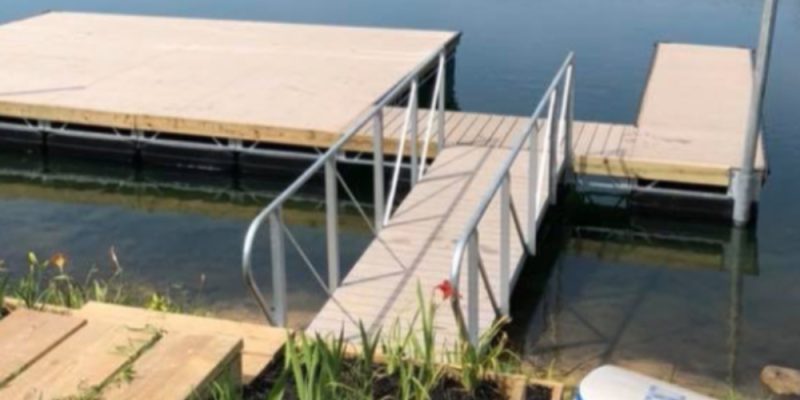Standing on a floating dock at low tide, you can sometimes feel oddly tall—almost like a captain surveying a toy harbor. Return six hours later and the same platform has glided upward, meeting your gaze at a whole new height. That gentle vertical dance is no accident; it’s the result of clever engineering that allows floating boat docks to adjust naturally to shifting water levels. Below is a plain-spoken look at how they manage the job, plus a few pointers for anyone considering a dock of their own.
1. Buoyancy: The Core Principle
At its heart, a floating dock is a set of buoyant chambers—often rotational-molded polyethylene cubes or pontoons—filled with closed-cell foam. These floats displace water, creating an upward force that matches the dock’s total weight plus a safety margin for people, gear, and the occasional labrador sprint. As the tide rises, more of each float is submerged, producing additional buoyant force that counters the extra water pressure. When the tide falls, the opposite happens: less float is submerged, but the reduced pressure means less lift is needed. It’s the same physics that keeps a surfboard bobbing whether you’re paddling in knee-deep or head-high swells.
2. Anchoring Systems: Flexibility With Control
A dock that simply drifted with every current shift wouldn’t last long, so anchoring is critical. Designers usually choose one of three systems, each allowing vertical travel while limiting horizontal wander:
- Pile Guides
Heavy timber, concrete, or steel piles are driven into the seabed. U-shaped collars—or “guides”—wrap around each pile, letting the dock slide up and down like a bead on a string. The guides absorb pounding wave forces while granting the dock several feet of tidal freedom. - Flexible Mooring Lines
In deeper or rocky bottoms where piles are impractical, heavy-duty ropes or elastic cables connect the dock to submerged concrete blocks. Stretch in the lines absorbs surge energy, and optional Seaflex-style elastomers expand or contract as the platform rises and falls. - Stiff-Arm Brackets
On rivers with moderate fluctuation, metal arms pivot horizontally from the shoreline to the dock. Think of an elbow joint that swings with water level changes but resists downstream drift.
3. Gangways: Maintaining Safe Access
Getting from solid ground to a moving target calls for an articulating gangway—essentially a hinged bridge. One end rests on the shore (or a fixed pier), and the other pins to the floating deck. As the dock climbs or drops, the gangway tilts, maintaining a walkable angle. Aluminum is a favorite material here: light enough for long spans, but rigid enough to feel secure under foot. Designers aim for a maximum slope of 1:4 (one foot of rise for every four feet of run) to comply with most accessibility guidelines.
4. Utilities That Flex With the Tide
Power and water lines can’t stretch like bungee cords, yet they still need to travel with the platform. The common workaround is a looped service drop—an S-curve of conduit or hose with enough slack to follow tidal range without kinking. For larger installations, floating utility trenches run alongside the dock, rising and falling in unison.
5. Preparing for Extremes
Storm surges and spring floods push docks beyond everyday fluctuations. Modern designs build in contingency:
- Freeboard Allowance – Extra floatation keeps decking safely above predicted high-water marks.
- Over-engineered Connectors – Stainless bolts, reinforced welds, and double-shear brackets shrug off short-term overloads.
- Break-away Sections – In marinas, sacrificial finger piers can detach under extreme stress, sparing the main walkway from catastrophic torque.
6. Routine Checks Keep Everything in Sync
Even the smartest system needs occasional TLC. Inspect pile collars for excessive wear, confirm mooring lines haven’t chafed, and verify gangway hinges pivot smoothly. After major storms, look for subtle deck tilts—early signs that a float has taken on water.
Final Thought
Floating docks succeed because they don’t fight Mother Nature; they cooperate. By pairing buoyant modules with flexible anchoring, hinged access, and stretchy utilities, these platforms shadow every rise and fall without compromising safety or usability. If your shoreline sees regular tidal swings—or unpredictable flood events—a well-designed floating dock isn’t just a convenience; it’s peace of mind that rises with the tide and never gets left high and dry.
This post was written by a professional at Supreme Marine Floating Docks. Supreme Marine Floating Docks is dedicated to providing top-quality floating docks and marine accessories that combine durability, innovation, and superior performance. While we are a new brand, our team brings over 50 years of combined industry experience, making us trusted marina contractors Miami. We are passionate about designing and delivering products that meet the highest standards, ensuring reliability and longevity in all marine environments. Whether for residential, commercial, or recreational use, our docks are crafted with precision and care, setting a new benchmark in the industry. At Supreme Marine, we don’t just build docks—we create lasting solutions.

Comments